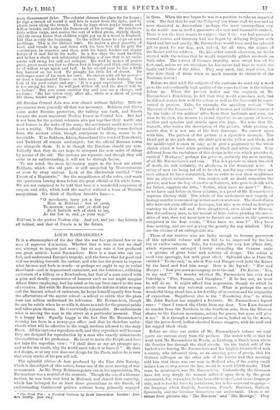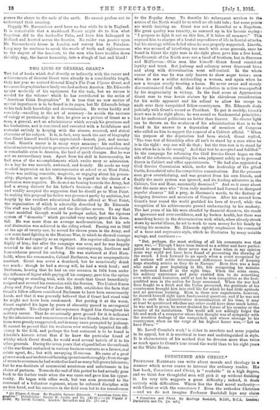LOUIS RAE3IAEKERS.*
IT is a ebmmonplace of tho day that the war has produced few or no men of supreme d'st:netion. Whether that is true or not we shall not attempt to inquire just now ; but at any rate it has produced one great satirist—Louis Raemaokors. Here is a man who can see, feel, and understand Europe's tragedy, and the forces that for good and evil are working beneath the surface, and who has the power to express what he sees and feels in words—or perhaps we ought to say in verbal shorthand—and in impassioned caricature, not the boisterous, rollicking caricature of a Gillray or a Rowlandson, but that of a man armed with a grim and deadly earnestness of humour such as one might imagine Albert Darer employing, had his mind or his age been tuned to the uses of iavective. But while Mr. Raemaekers avoids the defects of what we may call the blatant school of caricature, he keeps himself equally free from the affectations of the mystic school—a school so subtle that the plain man can seldom understand its relevance. Mr. Raemaekers, though he can be subtle when he so wills it, draws as a rule for the general public and takes plain themes. He is essentially a journalist. Ho understands what is moving the man in the street at a particular moment. That Is a happy fact. Equally happy is the fact that Mr. Raemaekers's training has been in a newspaper office, and that he therefore under- stands what will be effective in the rough medium allowed to the daily Press. All his cartoons reproduce well, and they reproduce well because they are designed for reproduction by a man who exactly understands the conditions of his profession. He is out to move the People, and does
not take the superfine view : "I shall draw as my art prompts me ; and as for the result, why the world must take it or leave it" He does not design, or at any rate does not design for the Press, unless he is sure that every stroke of his pen will tell.
The splendid trillion de luxe produced by the Fine Arts Society, which is the subject of this notice, forms one of the most moving of war monuments. As Mr. Perry Robinson points out in his appreciation, Mr. Resemackers was a neutral of the neutrals. Though the son of a German mother, he was born and bred in Holland, and shared that capacity, which has belonged for at least three generations to the Dutch, of understanding Continental politics without being primarily engaged • The Great War : a Hundred Cartoons by Louis Baemaebers. London : Fine Arts Society. [£10 102.]
in them. When the war began he was in a position to take an impartial view. The fact that he and the Telegraaf (on whose staff he was and is) were domiciled in Amsterdam—perhaps the most cosmopolitan city in the world—was in itself a guarantee of a sane and reasonable outlook. There is not the least reason to suppo es that if the war had pursued a normal course, and Germany had not begun by deluging Belgium with blood and lust and cruelty, Mr. Racmackers would have used his splendid gift to paint for our day, and, indeod, for all time, the crimes of the Kaiser and his soldiers. He, like other outside observers, no doubt started with tho notion that ho would impartially gibbet misdeeds on both sides. The torrent of German brutality soon swept him off his feet, and, unless we aro mistaken, he has never had time to touch the faults and follies of the Allies. They may exist, nay, must exist, but who dare think of them when so much remains to chronicle of the Teutonic horror I
Before we deal with the subjects of the cartoons we must say a word as to the extraordinarily high quality of the reproductions in the volume before us. When the present writer saw the originals at Mr. Raemaekers's Exhibition, he felt that they would reproduce well, but he did not realize how well the colour as well as the line could be repre- sented in process. Take, for example, the appalling cartoon "The Massacre of the Innocents." The mob of women and children separated by the butts of the soldiers' rifles from their husbands and sons, the men to ho shot, the women to crowd together in an agony of horror, seethes and splashes and shrieks upon the pogo. We note that Mr. Garnett, who writes the description of the picture, while praising it, asserts that it is not one of the best drawings. We cannot agree with him. The pattern of the picture is a figurative triumph. The blond girl in the pink dross, the little girl in the yellow and black, and the middle-aged woman in inky sable give a poignancy to the whole sketch which it loses when produced in black-and-white alone. Very different from the turbulence of this design is tho one which precedes it, entitled "Hostages," perhaps the greatest, certainly the most moving,
of all Mr. Raemaekors's cartoons. This is a picture in which the chill of death, its dull certainty, its aloofness, is the dominant note. A string of mon are being led off to bo shot, not for any crimes they aro even alleged to have committed, but in order to cow their neighbours into an abject submission. Our readers will no doubt remember the picture, and how the boy of twelve or fourteen, who goes to death with his father, supplies the title, "Father, what have we done " Here, as we have said before in these columns, is a proof of Mr. Raemaokors's supreme literary skill. The whole of the wickedness and tragedy of hostage murder is summed up in that narrow sentence. The blood of men who were not even offered as hostages, but who were seized as hceatages contrary to their will and then slaughtered, cries aloud to Heaven. But the ordinary man, in the tumult of false voices pleading the neces- sities of war, does not know how to furnish an answer to the question comprised in the four words, "What have we done 7" They have done nothing, and are not psying the penalty for any misdeed. They are the victims of an unforgivable sin.
Those of our readers who are lucky enough to become possessors of this splendid volume will not fail to be impressed by the last ten or twelve cartoons. Take, for example, the very last (Plate 100), which represents outraged Liberty strangling the German eagle —a picture of great force and nobility of design. The colour is used very sparingly, but with great effect. Splendid also is Plate 99, entitled "To the end," in which War and Hunger each hold tho Kaiser by the hand and lead him away. Here is the legend : " War and Hunger : Now you must accompany us to the end.' The Keiser: 'Yes, to my end.'" We wonder whether Mr. Raemaekers has ever read Coleridge's "Fire, Famine, and Slaughter." If he has not, we trust he will do so. It might afford him inspiration, though we admit he needs none from any external source. What is perhaps the most wonderful thing about him is his fertility of invention and his originality of exposition. Magnificent also is the "Wandering Jew," to which Mr. John Buchan has supplied a footnote. Mr. Raemaekers's legend runs : "Once I turned tho Christ from my door. Now I am doomed to wander from the Northern to tho Southern seas, from tho Western shores to the Eastern mountains, asking for peace, but none will give it me." It is through a vast expanse of snow, lashed on by the winds, that the green-faced, hollow-checked Kaiser staggers, with his staff and his ragged black cloak.
Before we close our notice of Mr. Raemaekers's volume we may quote one curious story from the preface. The writer tells us that ho went with Mr. Raemackers to Waals, in Limburg, a Dutch town where the frontier lies through the chief streets. On the Dutch side of the barbed-wire fencing Mr. Raemackers and his English friend talked with
a sentry, who informed them, as an amusing piece of gossip, that his
German colleague on the other side of the barrier had that morning told him that there was one man in Holland who, if the sentry could induce bins to step across the line, would be worth 12,000 marks. That man, he mentioned, was Mr. Raemackers. Undoubtedly the Germans have felt very deeply the wounds inflicted upon them by the great caricaturist, for, remember, he has been able to speak, not in one language only, and so lose his force by translation, but in the universal language— the language which English, Americans, French, Russians, Italians, Spaniards, and the Germans themselves can understand. There is no escape from pictures like "The Massacre" and "The Hostage." They pursue the sinner to the ends of the earth. He cannot profess not to understand their meaning.
Happily Mr. Raemackers need have no fear while he is in England. It is conceivable that a maddened Kaiser might do to him what Napoleon did to the bookseller Palm, and have him kidnapped in Holland and hurried across the frontier. No raider can pounce upon Mr. Raemaelcers's house in London and convey him to Potsdam. Long may he continuo to speak the words of truth and righteousness to the slayers of the innocent, to the men who have trodden down chivalry, nay, the barest humanity, into a slough of lust and blood I











































 Previous page
Previous page